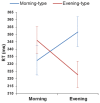The vigilance decrement in executive function is attenuated when individual chronotypes perform at their optimal time of day
- PMID: 24586404
- PMCID: PMC3929366
- DOI: 10.1371/journal.pone.0088820
The vigilance decrement in executive function is attenuated when individual chronotypes perform at their optimal time of day
Abstract
Time of day modulates our cognitive functions, especially those related to executive control, such as the ability to inhibit inappropriate responses. However, the impact of individual differences in time of day preferences (i.e. morning vs. evening chronotype) had not been considered by most studies. It was also unclear whether the vigilance decrement (impaired performance with time on task) depends on both time of day and chronotype. In this study, morning-type and evening-type participants performed a task measuring vigilance and response inhibition (the Sustained Attention to Response Task, SART) in morning and evening sessions. The results showed that the vigilance decrement in inhibitory performance was accentuated at non-optimal as compared to optimal times of day. In the morning-type group, inhibition performance decreased linearly with time on task only in the evening session, whereas in the morning session it remained more accurate and stable over time. In contrast, inhibition performance in the evening-type group showed a linear vigilance decrement in the morning session, whereas in the evening session the vigilance decrement was attenuated, following a quadratic trend. Our findings imply that the negative effects of time on task in executive control can be prevented by scheduling cognitive tasks at the optimal time of day according to specific circadian profiles of individuals. Therefore, time of day and chronotype influences should be considered in research and clinical studies as well as real-word situations demanding executive control for response inhibition.
Conflict of interest statement
Figures




Similar articles
-
Effects of chronotype and time of day on the vigilance decrement during simulated driving.Accid Anal Prev. 2014 Jun;67:113-8. doi: 10.1016/j.aap.2014.02.020. Epub 2014 Mar 4. Accid Anal Prev. 2014. PMID: 24636873
-
Chronotype and time-of-day influences on the alerting, orienting, and executive components of attention.Exp Brain Res. 2009 Jan;192(2):189-98. doi: 10.1007/s00221-008-1567-6. Epub 2008 Sep 23. Exp Brain Res. 2009. PMID: 18810396
-
Executive and arousal vigilance decrement in the context of the attentional networks: The ANTI-Vea task.J Neurosci Methods. 2018 Aug 1;306:77-87. doi: 10.1016/j.jneumeth.2018.05.011. Epub 2018 May 20. J Neurosci Methods. 2018. PMID: 29791865
-
Chronotype and synchrony effects in human cognitive performance: A systematic review.Chronobiol Int. 2025 Apr;42(4):463-499. doi: 10.1080/07420528.2025.2490495. Epub 2025 Apr 28. Chronobiol Int. 2025. PMID: 40293205
-
Circadian rhythms and decision-making: a review and new evidence from electroencephalography.Chronobiol Int. 2020 Apr;37(4):520-541. doi: 10.1080/07420528.2020.1715421. Epub 2020 Jan 31. Chronobiol Int. 2020. PMID: 32000532 Review.
Cited by
-
The Influence of Sleep Quality, Vigilance, and Sleepiness on Driving-Related Cognitive Abilities: A Comparison between Young and Older Adults.Brain Sci. 2020 May 28;10(6):327. doi: 10.3390/brainsci10060327. Brain Sci. 2020. PMID: 32481581 Free PMC article.
-
Auditory spatial attention gradients and cognitive control as a function of vigilance.Psychophysiology. 2021 Oct;58(10):e13903. doi: 10.1111/psyp.13903. Epub 2021 Aug 3. Psychophysiology. 2021. PMID: 34342887 Free PMC article.
-
A relational structure of voluntary visual-attention abilities.J Exp Psychol Hum Percept Perform. 2015 Jun;41(3):761-89. doi: 10.1037/a0039000. Epub 2015 Apr 13. J Exp Psychol Hum Percept Perform. 2015. PMID: 25867505 Free PMC article.
-
Probing sustained attention and fatigue across the lifespan.PLoS One. 2024 Jul 17;19(7):e0292695. doi: 10.1371/journal.pone.0292695. eCollection 2024. PLoS One. 2024. PMID: 39018279 Free PMC article.
-
Moving From Bilingual Traits to States: Understanding Cognition and Language Processing Through Moment-to-Moment Variation.Neurobiol Lang (Camb). 2021 Nov 11;2(4):487-512. doi: 10.1162/nol_a_00046. eCollection 2021. Neurobiol Lang (Camb). 2021. PMID: 37214629 Free PMC article. Review.
References
-
- Mackworth NH (1948) The breakdown of vigilance during prolonged visual search. Quarterly Journal of Experimental Psychology 1: 6–21 10.1080/17470214808416738 - DOI
-
- Parasuraman R, Davies DR (1977) A taxonomic analysis of vigilance. In: Mackie RR, editor. Vigilance: Theory, operational performance and physiological correlates. New York: Plenum. 559–574.
-
- Manly T, Lewis GH, Robertson IH, Watson PC, Datta AK (2002) Coffee in the cornflakes: time-of-day as a modulator of executive response control. Neuropsychologia 40: 1–6. - PubMed
Publication types
MeSH terms
LinkOut - more resources
Full Text Sources
Other Literature Sources

